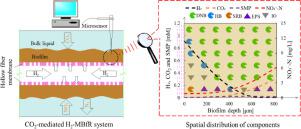Water Research ( IF 12.8 ) Pub Date : 2020-07-13 , DOI: 10.1016/j.watres.2020.116177 Minmin Jiang 1 , Junjian Zheng 2 , Patricia Perez-Calleja 3 , Cristian Picioreanu 4 , Hua Lin 5 , Xuehong Zhang 5 , Yuanyuan Zhang 2 , Haixiang Li 5 , Robert Nerenberg 3

|
The H2-based membrane biofilm reactor (H2−MBfR) is an emerging technology for removal of nitrate (NO3−) in water supplies. In this research, a lab-scale H2−MBfR equipped with a separated CO2 providing system and a microsensor measuring unit was developed for NO3− removal from synthetic groundwater. Experimental results show that efficient NO3− reduction with a flux of 1.46 g/(m2⋅d) was achieved at the optimal operating conditions of hydraulic retention time (HRT) 80 min, influent NO3− concentration 20 mg N/L, H2 pressure 5 psig and CO2 addition 50 mg/L. Given the complex counter-diffusion of substrates in the H2−MBfR, mathematical modeling is a key tool to both understand its behavior and optimize its performance. A sophisticated model was successfully established, calibrated and validated via comparing the measured and simulated system performance and/or substrate gradients within biofilm. Model results indicate that i) even under the optimal operating conditions, denitrifying bacteria (DNB) in the interior and exterior of biofilm suffered low growth rate, attributed to CO2 and H2 limitation, respectively; ii) appropriate operating parameters are essential to maintaining high activity of DNB in the biofilm; iii) CO2 concentration was the decisive factor which matters its dominant role in mediating hydrogenotrophic denitrification process; iv) the predicted optimum biofilm thickness was 650 µm that can maximize the denitrification flux and prevent loss of H2.
中文翻译:

基于H2的膜生物膜反应器中CO2介导的反硝化过程的新见解:一项实验和模型研究。
为H 2基膜生物膜反应器(H 2 -MBfR)是一种新兴技术用于除去硝酸盐(NO 3 -中的水供应)。在这项研究中,实验室规模的ħ 2 -MBfR配备有分离的CO 2提供系统和一个微传感器测量单元是为NO开发3 -由合成地下水除去。实验结果表明,高效的NO 3 -还原为1.46克通量/(米2 ⋅d)以水力停留时间(HRT)80分钟的最佳操作条件来实现,进水NO 3 -浓度为20毫克N / L,高2压力为5 psig,添加的CO 2为50 mg / L。考虑到H 2 -MBfR中底物的复杂反扩散,数学建模是了解其行为并优化其性能的关键工具。通过比较生物膜内测量和模拟的系统性能和/或底物梯度,成功建立,校准和验证了复杂的模型。模型结果表明:i)即使在最佳操作条件下,生物膜内部和外部的反硝化细菌(DNB)仍具有较低的生长速率,这分别归因于CO 2和H 2的限制;ii)适当的操作参数对于维持生物膜中DNB的高活性至关重要;iii)CO 2浓度是决定性因素,决定性因素在介导氢营养反硝化过程中起着主导作用。iv)预测的最佳生物膜厚度为650 µm,可以最大程度地提高反硝化通量并防止H 2损失。



























 京公网安备 11010802027423号
京公网安备 11010802027423号